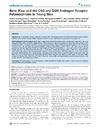Identificador persistente para citar o vincular este elemento:
https://accedacris.ulpgc.es/handle/10553/6536
| Title: | Bone mass and the CAG and GGN androgen receptor polymorphisms in young men | Authors: | Rodriguez-Gonzalez, Francisco Germán Dorado, Cecilia Olmedillas, Hugo Fuentes, Teresa Pérez-Gómez, Jorge Sanchis-Moysi, Joaquin Díaz Chico, Bonifacio Calbet, Jose A. L. Guadalupe-Grau, Amelia Ponce-González, Jesús Gustavo |
UNESCO Clasification: | 241106 Fisiología del ejercicio | Keywords: | Testosterone Bone Osteoporosis Androgens |
Issue Date: | 2010 | Journal: | PLoS ONE | Abstract: | BACKGROUND: To determine whether androgen receptor (AR) CAG (polyglutamine) and GGN (polyglycine) polymorphisms influence bone mineral density (BMD), osteocalcin and free serum testosterone concentration in young men. METHODOLOGY/PRINCIPAL FINDINGS: Whole body, lumbar spine and femoral bone mineral content (BMC) and BMD, Dual X-ray Absorptiometry (DXA), AR repeat polymorphisms (PCR), osteocalcin and free testosterone (ELISA) were determined in 282 healthy men (28.6+/-7.6 years). Individuals were grouped as CAG short (CAG(S)) if harboring repeat lengths of < or = 21 or CAG long (CAG(L)) if CAG > 21, and GGN was considered short (GGN(S)) or long (GGN(L)) if GGN < or = 23 or > 23. There was an inverse association between logarithm of CAG and GGN length and Ward's Triangle BMC (r = -0.15 and -0.15, P<0.05, age and height adjusted). No associations between CAG or GGN repeat length and regional BMC or BMD were observed after adjusting for age. Whole body and regional BMC and BMD values were similar in men harboring CAG(S), CAG(L), GGN(S) or GGN(L) AR repeat polymorphisms. Men harboring the combination CAG(L)+GGN(L) had 6.3 and 4.4% higher lumbar spine BMC and BMD than men with the haplotype CAG(S)+GGN(S) (both P<0.05). Femoral neck BMD was 4.8% higher in the CAG(S)+GGN(S) compared with the CAG(L)+GGN(S) men (P<0.05). CAG(S), CAG(L), GGN(S), GGN(L) men had similar osteocalcin concentration as well as the four CAG-GGN haplotypes studied. CONCLUSION: AR polymorphisms have an influence on BMC and BMD in healthy adult humans, which cannot be explained through effects in osteoblastic activity. | URI: | https://accedacris.ulpgc.es/handle/10553/6536 | ISSN: | 1932-6203 | DOI: | 10.1371/journal.pone.0011529 | Source: | PLoS ONE [EISSN 1932-6203], v. 5 (7), (Agosto 2010) |
| Appears in Collections: | Artículos |
SCOPUSTM
Citations
22
checked on Jun 8, 2025
WEB OF SCIENCETM
Citations
19
checked on Jun 8, 2025
Page view(s)
138
checked on Jan 11, 2025
Download(s)
151
checked on Jan 11, 2025
Google ScholarTM
Check
Altmetric
Share
Export metadata
This item is licensed under a Creative Commons License

